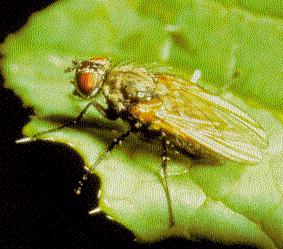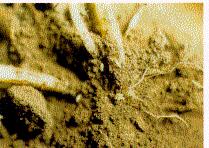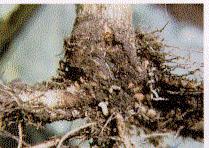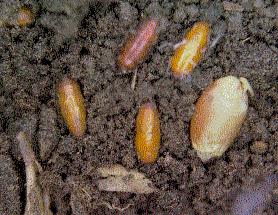Cabbage maggot
Cabbage maggot arrived in North America from Europe in the 19th centruy and is now common throughout the Prairies. The insect can be a serious pest of cruciferous crops such as canola, mustard, cabbage, rutabaga, radishes, cauliflower and broccoli.
Life Cycle
Cabbage maggot is capable of completing two full life cycles per year under Manitoba conditions. In Alberta, only one generation occurs per year.
| Figure 1. The adult cabbage maggot is a fly. |
 |
Adult
The adult cabbage maggot is a fly. It emerges in the spring from over-wintering puparia (cocoons) in the soil. A second generation may emerge later in the summer as the first generation completes its life cycle. Therefore, adult cabbage maggots may be found from May to October.
The cabbage maggot adult looks much like a common house fly, but is smaller and is ash grey in colour with a dark stripe along the back of the abdomen (figure 1).
| Figure 2. Cabbage maggot eggs. |
 |
Eggs
Female flies begin laying eggs within one week of emerging from the pupae and continue for a five to six week period. Each female will lay 50 to 200 eggs. The eggs are small (1mm), white and elongated (figure 2). Eggs are deposited at or near the base of host plants - usually just beneath the soil surface - and will hatch in 3 to 10 days.
| Figure 3. Cabbage maggot larvae. |
 |
Larvae
The larval stage is a small (6-10mm), white and legless maggot, similar in appearance to most fly maggots (figure 3). When the eggs hatch, the maggots move down into the soil and begin feeding on small roots and root hairs. Eventually, they tunnel into the plant's taproot. Maggot feeding will last for three to four weeks, after which they will pupate - either in the root itself, or in the soil.
| Figure 4. The pupae (cocoons) are elongated and brown, resembling small wheat kernels. |
 |
Pupae
The pupae (cocoons) are elongated and brown, resembling small wheat kernels (figure 4). Pupation occurs in the top 5 - 20 cm (2-8 inches) of soil. Pupation lasts about two weeks (unless interrupted by winter), after which the adult fly emerges and the cycle repeats itself (where there are two generations per year).
The summer's second generation of pupae usually remain dormant over the winter, and emerge as adult flies the following spring.
Crop Damage
The damaging life stage of this pest is the maggot. If enough maggots are present, the host plant can become completely severed from the root.
The level of infestation and subsequent yield losses are very dependent on environmental conditions. Infestations will be more severe following cool wet spring conditions.
Since eggs are laid over a period of time, and two generations may emerge during the growing season, maggots may be present continuously from June through to harvest.
Adult root maggots are known to move distances of at least a few kilometres in search of host plants. The adults are most abundant in canola during June and early July.
Canola and Mustard
Heavy maggot infestations in canola and mustard can hald blooming and cause severe lodging and yield losses. Additionally, maggot feeding damage may allow the entry of root rot fungi, causing further stress on the plant.
Polish canola varieties are more susceptible to maggot feeding than Argentine types. Yield losses as high as 50 per cent for Polish as compared to 20 per cent for Argentine canola varieties have been recorded in Alberta.
Vegetables
Infested vegetable crops will appear pale green and stunted, and may wilt on hot, dry days. Damage and yield losses can be severe for root crops such as radish and turnip.
Monitoring
| Figure 5. Infested roots. |
 |
If you cannot otherwise explain why your canola or mustard yields are lower than expected, the cabbage maggot may be the culprit.
In the spring, use sticky traps or sweep nets to look for the adult fly.
When searching for maggot infestations later in the season, carefully pull several host plants with the taproot intact. Look for evidence of maggot feeding on the root. Maggots will tunnel into the root and create channels along the outside. Check several plants in a least five or more locations.
If the maggot is present, you may need to wait several minutes for it to emerge and show itself, or cut into the root to assess for maggot damage.
Often, infested roots are darker in colour than healthy, uninfested roots (figure 5).
Control Options
Environmental and Biological
Cool temperatures and wet soil conditions at the time of egg laying are the main factors influencing the levels of cabbage maggot. Cabbage maggot infestations are more severe following a cool, wet spring. On the other hand, populations are generally lower in hot, dry years.
There are a number of natural biological control agents present on the Prairies, including a fungus that attacks adult flies, and a parasitic wasp and parasitic beetle that each attack the pupae. In addition, vast numbers of maggot eggs are eaten by rove beetles.
Insecticides
Controlling the maggot in canola is difficult at best. In-furrow application of granular insecticides with the seed will give some first generation maggot control. However, there are currently no pesticides available for control of maggot infestations in canola or mustard later in the season.
For high value cruciferous vegetable crops such as cabbage and broccoli, root damage and crop losses can be reduced by applying a soil insecticide drench at the time of transplanting and at two week intervals until the end of June, and again from late July to mid-August.
Refer to specific pesticide labels for registered crops and rates of application.
Cultural Controls
Cultural practices can have a considerable impact on cabbage maggot populations.
There is evidence that a moderate increase in canola seeding rates will reduce damage and yield loss experienced from maggot feeding. Heavier canola plant densities result in smaller basal stems which are less attractive to egg-laying females.
Tillage prior to seeding can reduce the level of emergence of adult flies. Tillage can move pupae nearer to the soil surface where they are more susceptible to attack by natural enemies. Fall tillage can expose the pupae to more severe environmental conditions over the winter. However, fall tillage can leave light-textured soils susceptible to erosion and should be used cautiously.
To avoid or reduce losses, producers should either grow crops that are not susceptible to the insect, or Argentine canola varieties.
Another pest management option is to control cruciferous weed species such shepherd's purse, stinkweed, wild mustard and flixweed that could act as host plants, and result in increased over-wintering populations of cabbage maggot.
Back to the cabbage page.
